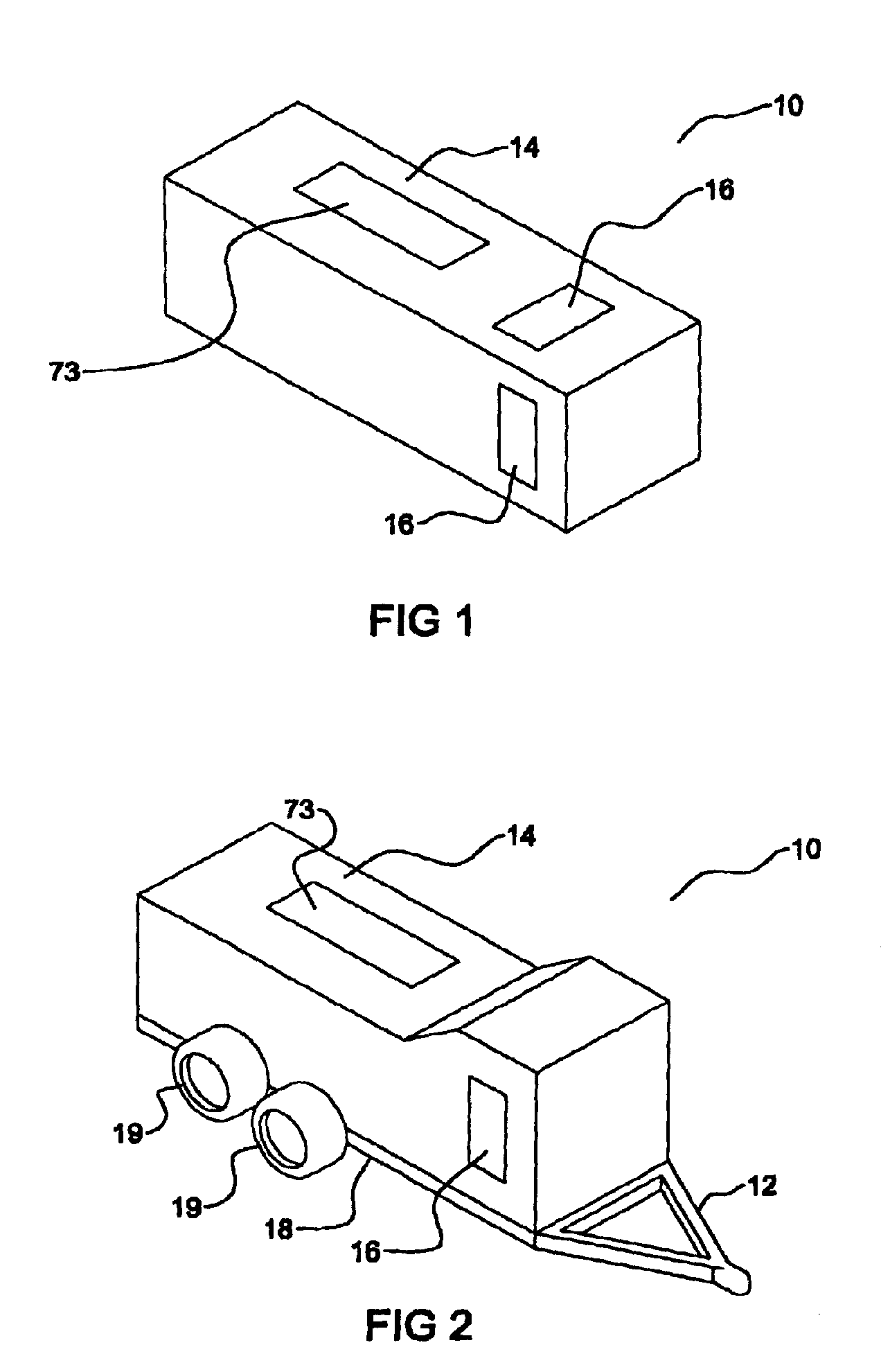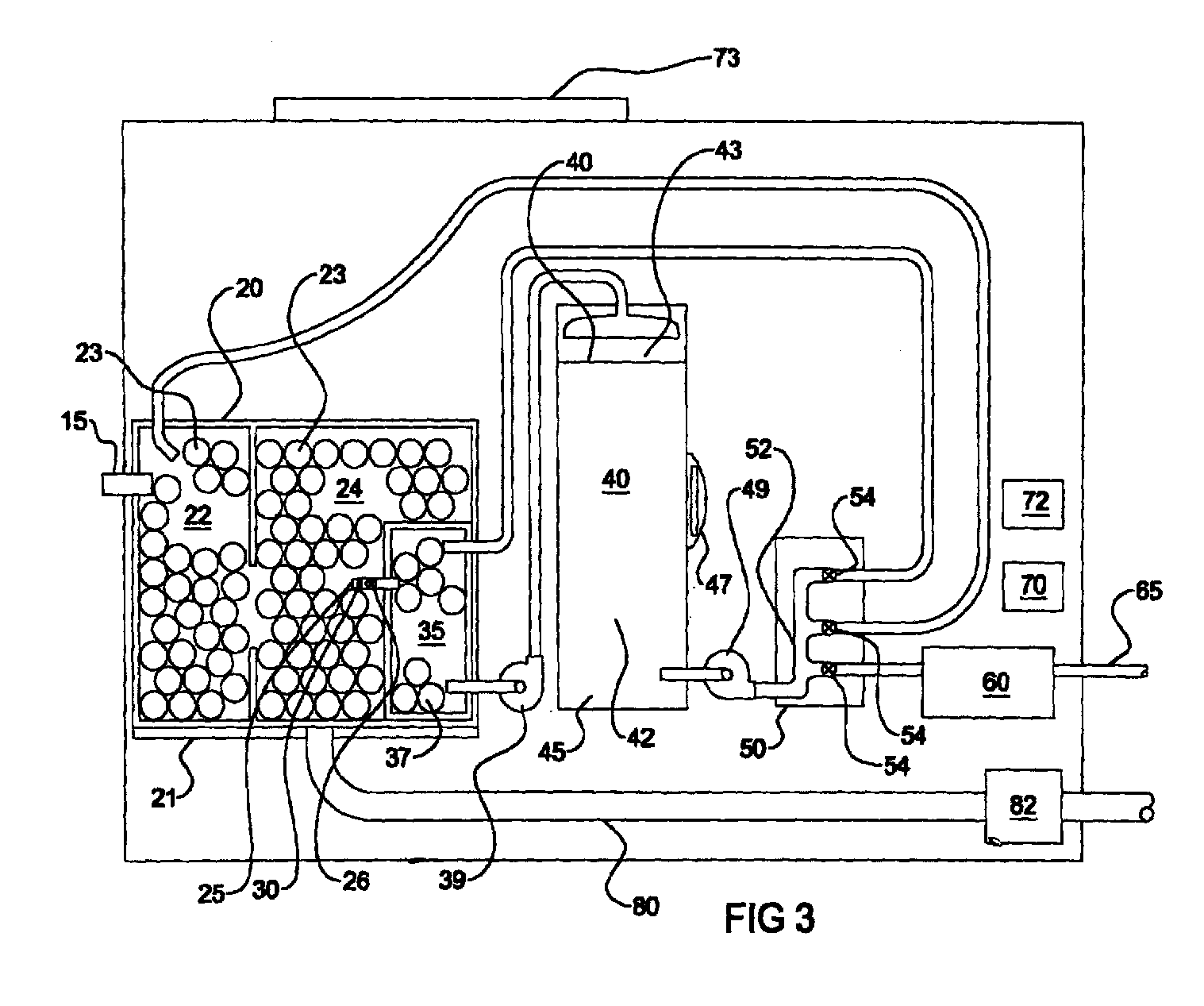[0012] The present invention provides an apparatus and method that allows waste water received by a portable waste
water treatment system to treat waste water while stationary at a remote location and then the portable waste
water treatment system can continue to treat the waste water while the portable waste
water treatment system is in transit between a first location and a second location. This allows the
transit time of the portable waste water treatment system to be utilized to improve the quality of the liquid in the portable waste water treatment system. Untreated waste water can be received by the system at a first location and during transport the waste water is treated by the portable waste water treatment system, improving the quality of the
effluent discharged from the portable waste water treatment system when it has arrived at the second location.
[0015] The distribution box is operative to direct the liquid to various components in the system depending upon the state of the portable waste water treatment system. If the portable waste water treatment system is stationary, the distribution box can direct a portion of the liquid for final
discharge as treated
effluent from the portable waste water treatment system onto the ground, if that is permitted at the location. The other portion of the liquid exiting the outlet end of the treatment tank is routed back to the recirculation tank to be mixed with liquid entering the recirculation tank from the
septic tank in order to dilute the liquid coming from the
septic tank. If the portable waste water treatment is in transit, a portion of the liquid exiting the treatment tank can be directed to the recirculation tank and the other portion of the liquid exiting the treatment tank directed back to the
septic tank to keep all of the liquid in the portable waste water treatment system moving through the entire system.
[0016] When the portable waste water system is going to be in transit for a relatively short period of time and this time period will not be long enough to sufficiently treat all of the waste water in the portable waste water treatment system, the distribution box can direct liquid exiting the treatment tank back only to the recirculation tank. The liquid in the recirculation tank will continue to be passed through the treatment tank further treating it with every pass through the treatment tank causing the liquid in the recirculation tank to be passed through the treatment tank and treated a number of times making it highly treated and substantially increasing its quality. This liquid will continue to pass through the treatment tank until the portable waste water system reaches the new location with the result that a portion of the liquid in the portable waste water treatment system will be highly treated as a result of being passed through the treatment tank numerous times. Once the portable
waste treatment system is at the second location a portion of this highly treated liquid can begin to be discharged from the portable waste water treatment system onto the ground surface, if it is permitted at the second location or alternatively discharged into a collection facility. The rest of the highly treated effluent in the recirculation tank can then be used dilute liquid entering the recirculation tank from the septic tank.
[0019] It is contemplated that one of the purposes of the present invention is to service work camps that move from location to location in a
continuous operation. Waste water generated at these work camps can be received by the portable waste water treatment system and treated while the portable waste water treatment system is stationary. When the
work site is no longer needed and the camp is moved, the portable waste water treatment apparatus can be transported to the next location. Rather than having to
discharge all of the liquid in the portable waste water treatment system before moving the portable waste water treatment system to the new location, the portable waste water treatment system can treat the waste water while enroute to the new location. Once the portable waste water treatment system arrives at the new location, the treated liquid can begin to be discharged at the new location and the portable waste water treatment apparatus can begin to receive new untreated waste water from the new site. By having the portable waste water treatment system treating waste water at
a site and then using the
transport time between a first location and a second location to treat the waste water, the present invention is able to begin discharging effluent that has been treated and substantially improved from the untreated waste water when the system arrives and the second location and can in many cases this treated effluent can be discharged on the ground at the new location.
[0020] Alternatively, if the portable waste water treatment system is to be used to transport waste water to a disposal site, the portable waste treatment system can be used to treat the waste water in transit to result in a better quality of resulting effluent at the disposal site. By increasing the quality of the effluent discharged by the portable waste water treatment system at a disposal site, the disposal site will often require less of a fee to dump the treated effluent than it would charge for dumping untreated waste water. Additionally, some disposal sites will not allow untreated waste water and by treating the waste water, the portable waste water treatment apparatus will be able to use a much wider range of disposal sites than if it was discharging untreated waste water, such as discharging the treated waste water at RV dumping grounds.
 Login to View More
Login to View More 


